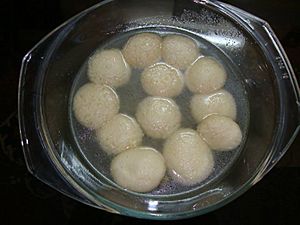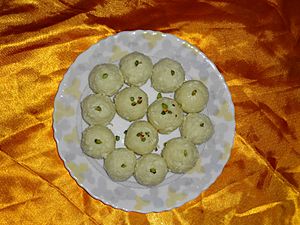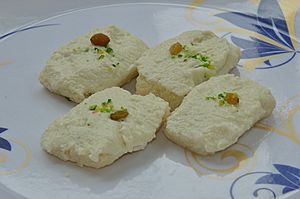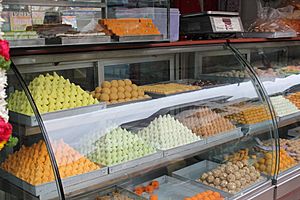Chhena facts for kids
| Type | Cheese | ||||||
|---|---|---|---|---|---|---|---|
| Place of origin | Indian subcontinent | ||||||
| Main ingredients | Milk | ||||||
| 719 calories kcal | |||||||
|
Chhena (pronounced "chay-na") is a type of cheese curd from the Indian subcontinent. It's made from water buffalo or cow milk. To make it, people add food acids like lemon juice or calcium lactate to the milk. Then, they strain the liquid part (called whey) away.
Chhena can be pressed to make paneer, which is a firm farmer cheese. It's also often shaped into balls to create many delicious desserts and sweets from the Indian subcontinent (called mithai). Some popular sweets include khira sagara, chhena kheeri, rasabali, ras malai, chhena jalebi, chhena gaja, chhena poda, pantua, rasogolla / রসগোল্লা, and sandesh. For most sweets, chhena made from cow milk is preferred.
Chhena is widely made in Bangladesh and eastern India. In India, there are rules about how much moisture (water) and milk fat chhena should have. In 2009, India produced about 200,000 tonnes of chhena each year. The state of Uttar Pradesh makes the most chhena, while West Bengal eats the most. Chhena is similar to paneer, but it's kneaded while warm, which gives it a smooth, soft texture, unlike paneer which is firm.
Contents
The History of Chhena
Ancient Indian texts called the Vedas mention milk products like curds. However, they don't seem to talk about chhena specifically. Later, in the 12th century, a cooking text called the Manasollasa described how to sour milk and drain the curds to make a base for sweets. This text even mentioned mixing the cheese with rice flour, shaping it into balls, and deep-frying them for desserts. Some historians believe that heat-acid coagulated milk products, like chhena or paneer, might have existed in India as early as 75-300 CE.
Another idea is that the Portuguese people brought the method of "breaking" milk with acid to Bengal in the 17th century. Before the Portuguese arrived in 1517, many Indian sweets were made with khoa, which is solidified condensed milk. Curdling cow's milk was not common or even allowed in some Hindu traditions. Bengalis learned how to make cottage cheese from the Portuguese, and this might have inspired chhena. So, some believe that Indian acid-set cheeses like paneer and chhena first appeared in Bengal because of Portuguese influence. Sweet makers called 'moria' in Bengal created many chhena-based sweets. The Halwai caste has traditionally made these products.
In the past, farmers often made chhena and sent it to sweet makers. Smaller producers used traditional methods, which gave their chhena unique flavors. Today, sandesh is one of the most popular sweets made with chhena. Chhena products are now a special kind of food, competing with many new foreign desserts.
Changes in India's economy, like liberalization and globalization, are affecting the traditional cheese industry. Foreign companies want to sell their cheeses, like mozzarella, in India. Traditional chhena makers worry they can't compete because they would need to follow very strict rules, which would cost a lot more. Indian dairy farmers are concerned about losing jobs if foreign dairy products become too popular.
How Chhena is Made
India produces about 200,000 tonnes of chhena every year. Traditionally, chhena is made in a large pan called a Karahi, similar to how ricotta cheese is made. In India, rules say chhena must be made from cow or buffalo milk, or a mix of both. It can be curdled using sour milk, lactic acid, or citric acid. Sometimes, old acidic whey from a previous batch is used to avoid waste.
First, the milk is boiled for about 10 minutes. Then, it's allowed to cool slightly to 75-80 degrees Celsius. At this point, an acid or old whey is added. The milk then separates, and the curds (chhena) float to the top. These curds are then strained through a muslin cloth to remove the liquid whey. The chhena is often pressed by gravity or with weighted boards to remove more whey. The longer it's drained, the firmer the chhena becomes. While usually made in small batches, chhena can also be made continuously in large factories.

For making sweets, the drained chhena is kneaded on a wooden board. sugar and a binding agent like arrowroot or semolina flour are mixed in. Machines are often used for kneading now. The chhena is then rolled into balls for making sweets. Some popular sweets that use chhena are rasogolla, sandesh, chum-chum, chhana murki, chhana podo, rasomalai, and chhana balushahi. Chhena has also been mixed with cream to make a spreadable cheese.
The liquid whey that is usually thrown away can be used to make healthy drinks. It can be fermented with special bacteria. This process turns lactose (milk sugar) into lactic acid, which means people who can't digest lactose might be able to drink these beverages. Whey can also be used to make pancakes. However, the whey must be very clean and handled carefully. A lot of whey, about three million tonnes, is produced each year and often dumped into the environment. This can be a big problem because it pollutes the water.
What Chhena is Like
The way chhena is made affects its texture. If the milk has less than 4% fat, the chhena can be hard and rubbery. If it has more than 5% fat, it might be greasy. Buffalo milk usually makes more chhena than cow's milk. But if only buffalo milk is used, the chhena can be hard and chewy with an uneven texture. Chhena can also be made with soy milk, especially when mixed with 75% cow's milk. The type of milk and the season also change the quality of chhena.
Chhena often feels like 'whipped cream cheese'. Its texture can be smooth, pasty, or crumbly. Chhena contains fat, protein, vitamins A and D, and is low in sugar. Chhena made from cow's milk is light yellow, moist, soft, and smooth. Chhena from buffalo milk is whitish. Both have a slightly sweet and mildly acidic taste. Making chhena at higher temperatures results in a grainy and hard cheese, while lower temperatures make it sticky and slow to dry. Chhena usually has a mild taste and is easy to shape.
Storing Chhena Safely
Chhena spoils quickly because it has a lot of moisture, especially without good cold storage and careful handling. Even after boiling, some bacteria might survive. India's warm and humid climate also makes products spoil faster. Refrigeration helps a lot, but it's not always available everywhere. Scientists have tried to turn chhena into a powder to make it last longer, but the powdered form wasn't good for use.
Chhena-based sweets should be kept in the refrigerator and eaten within 2–3 days. Quality control is a big challenge in India. Sometimes, dishonest makers add starch to chhena to make more money. This can cause diarrhea and stomach pain. If chhena is not handled properly, it can get contaminated. A study in Kolkata found harmful bacteria like E. coli in many chhena sweets. This happens because of unclean production, handling, storage, and transport. Softer sweets are more likely to have E. coli because they have less sugar to preserve them and more moisture. These sweets are often sold without packaging and made in small batches.
|
See also
 In Spanish: Chhena para niños
In Spanish: Chhena para niños





